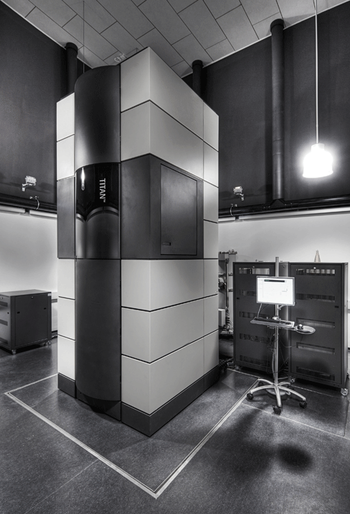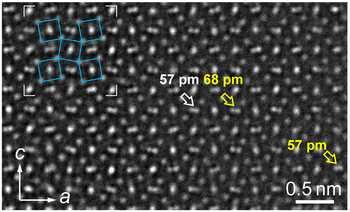Titan G3 50-300 PICO

The TFS Titan G3 50-300 PICO is a unique fourth generation transmission electron microscope which has been specifically designed for the investigation of a wide range of solid state phenomena taking place on the atomic scale and thus necessitating true atomic resolution analysis capabilities. For these purposes, the PICO is equipped with a Schottky type high-brightness electron gun (FEI X-FEG), a monochromator unit, a CS probe corrector (CEOS DCOR), a CS-CC achro-aplanat image corrector (CEOS CCOR+), a double biprism, a post-column energy filter system (Gatan Continuum K3-IS) as well as a 16 megapixel CMOS detector (Gatan OneView IS). Characterised by a TEM and STEM resolution of 50 pm at 200 kV accelerating voltage, the instrument is one of the few chromatically-corrected high resolution transmission electron microscopes in the world. Operation instructions and technical specifications for the instrument are given below.
The microscope is managed by a group of instrument officers: Juri Barthel, Lei Jin, or Hongchu Du. Access is granted only on prior discussion of feasibility.
Users of the Titan G3 50-300 PICO are kindly asked to quote a technical description of the instrument published in the Journal of large-scale research facilities 1 (2015) A34 when referring to the use of this instrument in publications.
Status
ONLINE
Current issues
Pending issues
- Possible re-calibration required for 80 keV and 50 keV alignments
Special rules of operation
- Operation with CCOR+ power supplies ON (normal operation): Set the electrostatic elements of the CCOR+ to zero until in state "All vacuum" or ”Vacuum Ready” a good working pressure is reached BEFORE
- running a cryo cycle,
- exchanging specimens,
- making serious changes to the vacuum settings
- Overnight state CCOR+ power supplies ON (over night and during longer pause): It is recommended as overnight status of the CCOR+ as well to set the electrostatic elements to zero, namely QE3_Pc, QE3_Nc, QE8_Pc, QE8_Nc. Reloading the image corrector alignment is only allowed after a good working pressure is reached.
- Operation with CCOR+ power supplies OFF (service): In case the CCOR+ electronics is switched off, charging of the electrodes of the CCOR+ has to be prevented. As there is no lock out/tag out method for the gun valve, we strongly recommend after shut down of the CCOR+ electronics to:
- Unplug the cables of the four electrostatic elements at the back side of the electronics cabinet and to
- Plug them into the 4 provided short circuit plugs. Then the grounding of the electrodes is provided by the screen of the cables.
- Column venting (service only): If the column is going to be vented, the CCOR electronics have to be shut down (clear all excitations, disable the Lambda output and set its main switch to off). Also all detectors have to be warmed up before venting the projection! -- Repowering the CCOR electronics and loading the image corrector alignment is not allowed before pumping one night with good pressure in the state "All vacuum" or ”Vacuum Ready”.
Applications

The configuration of the FEI Titan G3 50-300 PICO allows a variety of advanced transmission electron microscopy techniques to be applied to a wide bunch of solid state materials. These techniques include
- electron energy loss spectroscopy (EELS)
- energy filtered transmission electron microscopy (EFTEM)
- high resolution transmission electron microscopy (HRTEM)
- high resolution scanning transmission electron microscopy (HRSTEM) with annular detectors for
- bright-field,
- annular dark-field, and
- high-angle annular dark field imaging,
- (currently not supported) off axis electron holography (OAEH),
- electron tomography (ET), and
- combinations of the previous techniques.
Apart from the special case of the utilization of dedicated cooling or heating stages, the Titan PICO will allow samples to be investigated either under room temperature or liquid nitrogen cooling conditions at a vacuum level of about 10–8 mbar. Techniques that cannot guarantee a stable vacuum, such as heating or gas injections are not supported.
The Titan PICO is not intended for the investigation of aqueous, contaminated, ferro-magnetic or organic samples without further discussions with the instrument officers and the ER-C general management.
Instructions
The operation instructions given below and on the subsequent pages are ment as guidelines and knowledge base. They do not replace the direct introduction to the microscope usage by the instrument officers or your project manager. There are many steps and pitfalls in the operation of this microscope that can seriously harm you or the expensive equipment.
Since the PICO microscope is a very complex machine, please do not edit the instructions below before discussing the changes with the instrument officers. These instructions are also for internal use only, the information should not be published outside the Forschungszentrum Jülich.
Microscope operation
- General instructions
- Changing the sample
- CCOR+ tuning procedures
- Changing the high-tension
- Switching between TEM and STEM
- DCOR tuning procedures
- Monochromator tuning procedures
- Continuum GIF tuning procedures
- (OBSOLETE) Quantum GIF tuning procedures
- Warm-up, Shutdown and Start
Knowledge
Specifications
Microscope performance
- Acceleration Voltage: 50 kV, 80 kV, 200 kV, and 300 kV
- Information Limit (TEM)
- @ 300 kV < 0.55 Å
- @ 200 kV < 0.50 Å
- @ 80 kV < 0.80 Å
- @ 50 kV < 1.0 Å
- Resolution (STEM)
- @ 300 kV < 0.5 Å
- @ 200 kV < 0.8 Å
- System Energy Resolution
- @ 300 kV & 200 pA < 0.20 eV
- @ 200 kV & 30 pA < 0.12 eV
- @ 80 kV & 40 pA < 0.10 eV
Note that the above values are as specified on delivery. They may change over time, usually with a tendency of degradation.
Detectors
- Gatan OneView bottom mounted CMOS 16 Megapixel camera with in-situ recording capability.
- Gatan Continuum image filter (GIF) with a K3 in-situ and a CMOS detector, BF and dark field STEM detectors, STEMx system.
- Fischione Model 3000 HAADF STEM detector.
Specimen holders
- Double tilt low background holder (α tilt range ± 40°)
- High field of view single tilt tomography holder (α tilt range ± 70°)
- Dual-axis tomography holder (α tilt range ± 50°)
- On-axis rotation tomography holder (α tilt range 360°)
- Further in-situ sample holders are available
- Total system drift < 2 Å/min (rms)
Instrument officers
When opening a service call, refer to tool number D3220.
The Titan PICO instrument officers are:
- - Juri Barthel (general, HR(S)TEM, CCOR+, DCOR),
- - Hongchu Du (HR(S)TEM, Monochromator, EELS), and
- - Lei Jin (HR(S)TEM, EELS)
Location
Building: 05.2S
Operator room: 2007
Microscope room: 2005
Operator Phone: +49 2461 61 9271